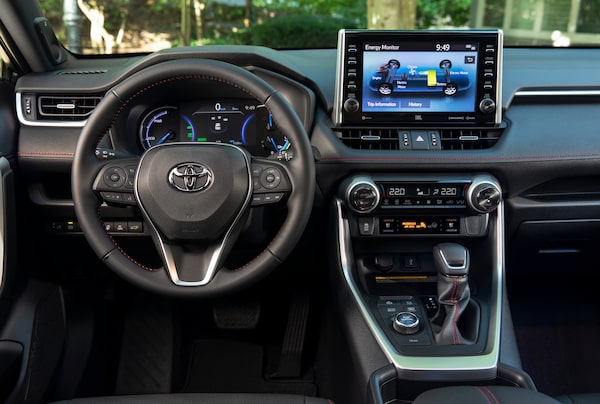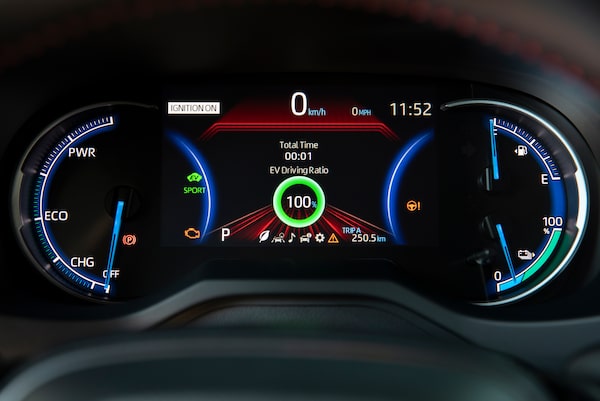The Hyundai Tucson PHEV and Toyota RAV4 Prime are two of the more popular hybrid compact-crossover options Canadians have to choose from.Jeremy Sinek/The Globe and Mail
If you are looking for electrification in your next vehicle, but aren’t ready for the compromises of a pure electric car, plug-in hybrid electric vehicles (PHEVs) are an easy option for those still deterred by range and recharging anxiety.
They have enough battery life to cover most Canadians’ daily driving needs, but still have a gas engine and tank for longer trips.
There are currently five PHEVs available in the massive compact-crossover segment that forms the heart of the Canadian market. Here is how two of the more popular ones stack up against each other.
The Toyota RAV4 Prime joined the extensive RAV4 lineup two years ago. The Hyundai plug-in option was a late addition to the Tucson lineup that was all new for 2022. Each PHEV is available in two trim grades, with Hyundai staking a clear claim in affordability at $43,699 for the Luxury and $46,399 for the Ultimate; the Toyota’s SE and XSE trims ask $46,090 and $52,690, respectively.
Until recently, the Toyota’s price penalty was offset by its 18.1-kilowatt-hour battery, which qualified it for the full $5,000 federal rebate on zero-emissions vehicles, whereas the Hyundai’s 13.8-kilowatt-hour battery was worth only a $2,500 rebate. However, revisions to the program now base the rebate on electric range, and the Tucson’s 53 kilometres earns it the same $5,000 rebate as the Toyota’s 68 kilometres.
Battery size aside, the automakers combine their electric and mechanical powertrains quite differently. The RAV4 uses Toyota’s long-familiar hybrid technology up front, pairing a naturally aspirated 2.5-litre gas engine and two electric motors that power a continuously variable transmission, while a separate electric motor at the rear provides all-wheel drive. The Tucson pairs its single electric motor with a 1.6-litre turbocharged gas engine and a conventional six-speed automatic transmission, and has the same mechanically driven rear axle as its non-hybrid siblings.
The Tucson has novelty on its side with a new look for 2022.Jeremy Sinek/The Globe and Mail
Looks
Now entering its fifth model year as a top seller in Canada, the chunky-SUV look of the current RAV4 is beginning to seem awfully familiar, though the Prime has distinct LED lights and the XSE is further distinguished by its black roof. The Tucson was new for 2022 and has novelty on its side, if you don’t mind its overtly chiselled body sides.

The Toyota RAV4 Prime has a high-and-centre, free-standing touch screen, along with plenty of real buttons and knobs.Jeremy Sinek/The Globe and Mail
Interior
Drivers should be equally at home in either contender, thanks to great sight lines and ample at-the-wheel adjustability. Each challenges ergonomic convention in different ways: a high-and-centre, free-standing touch screen on the Toyota but with plenty of real buttons and knobs, versus a subtler integrated screen but mostly touch-sensitive controls on the Hyundai; a conventional shift lever on the Toyota versus push-buttons on the Hyundai. Depending on the trim, the Hyundai offers more seat adjustability for the front passenger, and a little more rear-seat space too (though not as much as in other Tucsons, as the PHEV battery steals some legroom).
The Hyundai Tucson PHEV has mostly touch-sensitive switchgear.Jeremy Sinek/The Globe and Mail
Performance
We weren’t able to measure the Tucson’s acceleration, but you don’t need test gear to tell which would be quicker on the drag strip: The RAV4′s six-second sprint to 100 kilometres an hour is quick by any standards, let alone for a green gas miser. Arguably, though, the Prime is almost too quick for its own good; despite its all-wheel drive, aggressive launches can make the front tires yelp, and its cornering manners are less sports-car-like than its straight-line pace. And of course, there’s the random-revving effect of the Toyota’s continuously variable transmission.
The Tucson, with its traditional yet seamless stepped transmission, mechanical all-wheel drive and nicely muted gas engine, delivers a more traditional and refined performance feel, as well as more engaging handling (though the Toyota’s ride is more supple).
On environmental performance, the RAV4 wins. By the official numbers, it has 15 kilometres more electric range, its combined energy consumption rates 2.5 litres equivalent (Le) per 100 kilometres versus the Tucson’s 2.9, and combined gas consumption in hybrid mode is six litres per 100 kilometres versus 6.7.
The lab results were confirmed by real-world consumption in the Automobile Journalists Association of Canada’s EcoRun last May: After both vehicles were driven 800 kilometres almost entirely in hybrid mode by seven different drivers, the Toyota averaged 5.3 litres per 100 kilometres and the Hyundai averaged six.
Score one to the Hyundai for its slightly more powerful on-board charger, 7.2 kilowatts versus 6.6. On the other hand, only the Toyota has a charge-while-driving mode.

The Toyota RAV4 Prime comes with standard active driver aids, such as adaptive cruise, front collision braking and lane-departure assist.Jeremy Sinek/The Globe and Mail
Technology
Even at their lower prices, the Hyundai contains more standard features than the Toyota. In the RAV4, for example, you have to buy the top trim and add a $5,400 package to get navigation and a surround-view camera — both are standard on the Tucson Ultimate — and to get ventilated seats that are standard on both Tucsons.
Likewise, quite a few features, such as wireless phone charging, satellite radio and a sunroof, are standard on the lower-trim Tucson, but included only on the top-trim RAV4. The Toyota is, however, competitive in terms of standard active driver aids, such as adaptive cruise, front collision braking and lane-departure assist.
Larger batteries steal some cargo space, but the Tucson has 903 litres of cargo space.Jeremy Sinek/The Globe and Mail
Cargo
Larger batteries steal some cargo space compared with their respective siblings, but the remaining spaces are still in the ballpark with other compact crossovers: seats up, 903 litres for the Tucson and 945 for the RAV4, seats down 1876 and 1786, respectively. Maximum tow ratings are 2,000 and 2,500 pounds respectively.
The verdict
In the current vehicle-inventory climate, your best choice might be whichever you can get sooner. That aside, the Toyota makes a compelling case with its superior acceleration, longer electric range and lower fuel consumption, not to mention the expectation of Toyota reliability (backed by a longer warranty on the hybrid components). On the other hand, the Tucson delivers more standard features at a much lower price, plus a more pleasing and conventional overall driving experience. Final word? The Toyota is a better plug-in hybrid, but not better enough over all to justify its higher price.

The Toyota RAV4 Prime can travel 68 kilometres on electric power.Jeremy Sinek/The Globe and Mail
Hyundai Tucson Ultimate PHEV
- Base price/as tested: $46,399/$46,599
- Powertrain: 1.6-litre turbo four-cylinder/67-kilowatt electric motor
- Transmission/drive: Six-speed automatic/all-wheel drive
- Fuel consumption (litres per 100 kilometres): 6.8 city/6.6 highway in hybrid mode; 2.9 litres equivalent per 100 kilometres combined in EV mode
- Alternatives: Ford Escape PHEV, Kia Sportage PHEV, Mitsubishi Outlander PHEV, Toyota RAV4 Prime
Toyota RAV4 Prime XSE
- Base price/as tested: $52,690/$58,090
- Powertrain: 2.5-litre four-cylinder/134-kilowatt electric motor
- Transmission/drive: Continuously variable automatic/40-kilowatt rear electric motor
- Fuel consumption (litres per 100 kilometres): 5.7 city/6.4 highway in hybrid mode; 2.5 litres equivalent per 100 kilometres combined in EV mode
- Alternatives: Ford Escape PHEV, Hyundai Tucson PHEV, Kia Sportage PHEV, Mitsubishi Outlander PHEV